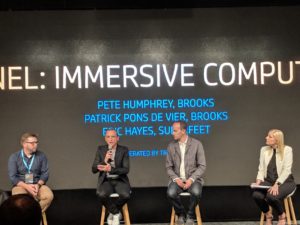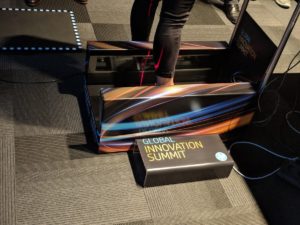 Summits provide an immersive experience for attendees, gathering in the labs where innovation is born and hearing directly from the executives leading the charge. HP’s Global Innovation Summit, held last week in Barcelona, offered an inside look at the company’s view of Industry 4.0, including the role of collaboration as being key to the path forward. Advanced technologies including 3D printing and immersive computing were particularly in focus at the forward-thinking event, and following a deep dive into HP Inc.’s approaches and strategies on day one of the summit, day two highlighted real-world applications with customers sharing their stories. A 3D printing panel discussion opened the morning, followed by a conversation from users focused on immersive computing.
Summits provide an immersive experience for attendees, gathering in the labs where innovation is born and hearing directly from the executives leading the charge. HP’s Global Innovation Summit, held last week in Barcelona, offered an inside look at the company’s view of Industry 4.0, including the role of collaboration as being key to the path forward. Advanced technologies including 3D printing and immersive computing were particularly in focus at the forward-thinking event, and following a deep dive into HP Inc.’s approaches and strategies on day one of the summit, day two highlighted real-world applications with customers sharing their stories. A 3D printing panel discussion opened the morning, followed by a conversation from users focused on immersive computing.
Tricia Dugan, Vice President, Worldwide GTM Immersive Computing, HP led a conversation in immersive computing. With FitStation powered by HP a rising platform for the footwear industry, it was here that the discussion focused, with Pete Humphrey, Vice President, Research & Development, and Patrick Pons de Vier, SVP Global Footwear, both of Brooks, and Eric Hayes, Chief Marketing Officer, Superfeet sharing their experiences.
“We spent, of our 40 years now, maybe 35 doing more or less the same thing. We know the biomechanics, we know what happens under the foot; we were limited by mass manufacturing,” Hayes said of Superfeet’s approach to a footwear experience.
“About five years ago, we started to see things change, that allowed us to do things in a new way… We didn’t start off to create a 3D printed insole, we started off to create a customized insole. We were able to deliver on our wants and needs by Multi Jet Fusion coming to the market. With this strength, flexibility, and cost effectiveness, now we can do this — what Superfeet wanted to do for 35 years, now we can deliver on it.”
Pons de Vier and Humphrey highlighted the messaging that for Brooks, the focus is always on the customer, on the runner and creating “the most personalized running experience,” as the former noted. 3D printing is enabling this long-standing dream, as well.
“Yes, it’s going to change the industry,” Pons de Vier said, picking up right from Hayes. “The reality of the running industry is that it’s been very, very complacent for the past three decades, with evolution incremental. It’s been a very easy profit in a way. …When you look at the level of injuries, it’s the same as 30 years ago; we don’t take care of the runner. People still get injured and it’s not acceptable. There is a beautiful opportunity now to personalize the shoe. It’s a game changer. It will be hitting the market because it’s true.”
Hayes affirmed that this game-changing capability will impact footwear brands as well as consumers as products begin to come together for realizable personalization. Shortening development cycles with MJF 3D printing is “upending that particular apple cart,” he said of the current 20-month development timeline for new designs. Shortening the cycle to under one year is a “big, big change” that, “without getting too dramatic, right now can literally only exist on Multi Jet Fusion.” The choice of technology impacts the level at which Brooks and Superfeet are able to take their ideas to market.
“One of the really cool things about FitStation is our opportunity to model our product after each individual,” Humphrey said. “I want to share with you where we are with our Genesys project, as we call it because it’s the first of its kind. Brooks Genesys, the first personalized high-performance running shoe.”
He held one of the first of the Genesys shoes up to show off, illustrating the concept the company had presented late last year and has been moving forward with as production picks up.
“Mike now has a size Mike, because that’s what Mike needs,” Hayes said.
“Shoe size is dead. It’s your size,” Pons de Vier noted during the interactive Q&A.
Later in the summit, I appreciated the opportunity to sit down with Hayes and HP’s Head of Product, Immersive Computing, Josh St. John for a discussion of immersive computing and a focus on personalization in footwear, as well as with Pons de Vier, Humphrey, and Dugan for a deeper look at what the Genesys shoes represent for a data-driven solution in ‘running happy.’ Stay tuned for these interviews.
Discuss HP, Multi Jet Fusion, the future of manufacturing, and other 3D printing topics at 3DPrintBoard.com or share your thoughts in the Facebook comments below.
[All photos: Sarah Goehrke]
Subscribe to Our Email Newsletter
Stay up-to-date on all the latest news from the 3D printing industry and receive information and offers from third party vendors.
You May Also Like
Gorilla Sports GE’s First 3D Printed Titanium Cast
How do you help a gorilla with a broken arm? Sounds like the start of a bad joke a zookeeper might tell, but it’s an actual dilemma recently faced by...
Nylon 3D Printed Parts Made More Functional with Coatings & Colors
Parts 3D printed from polyamide (PA, Nylon) 12 using powder bed fusion (PBF) are a mainstay in the additive manufacturing (AM) industry. While post-finishing processes have improved the porosity of...
$25M to Back Sintavia’s Largest Expansion of Metal 3D Printing Capacity Since 2019
Sintavia, the digital manufacturing company specializing in mission-critical parts for strategic sectors, announced a $25 million investment to increase its production capacity, the largest expansion to its operations since 2019....
Velo3D Initiates Public Offering in a Bid to Strengthen Financial Foundations and Drive Future Growth
Velo3D (NYSE: VLD) has been among a number of publicly traded 3D printing firms that have attempted to weather the current macroeconomic climate. After posting a challenging financial report for 2023,...



































